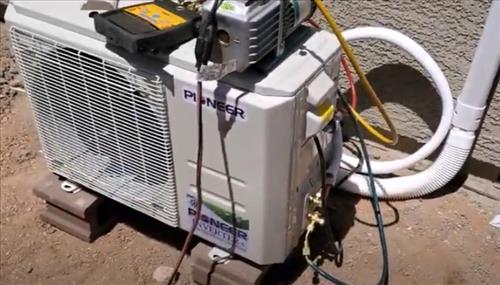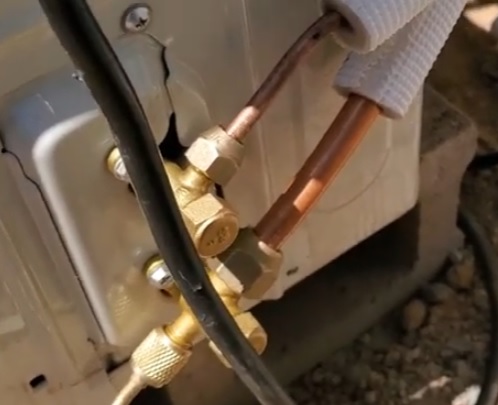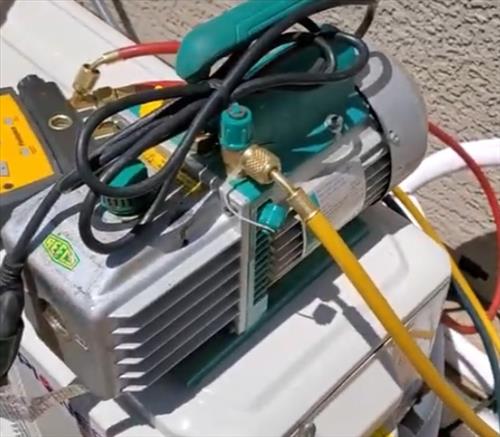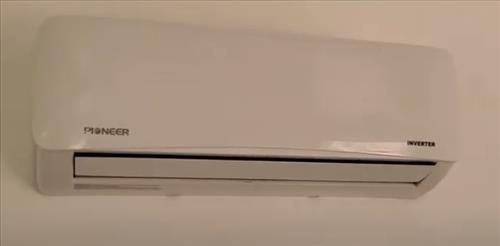
Mini split units have become very popular since they are highly efficient and versatile units.
They come in many shapes and sizes, along with many DIY kits that homeowners can install.
If you are new to mini split units below, we answer many common questions that come up when a buyer is looking to purchase a unit.
How Hard is a Mini Split to Install?
-
Installing a mini split will require drilling a 2-3 inch hole through a wall to the outside along with electrical and connecting the refrigerant lines.
- Drill a Hole in the Wall
- Connect Electrical
- Connect Refrigerant Lines
- Vacuum Down the System and Test for Leaks
Drilling a 2-3 hole in the wall is not difficult with a hole saw, but some walls are harder than others.
For example, a brick wall will be harder to drill through compared to a wood wall.
The mini split will need electrical run to the unit, either 115 or 230 volts, depending on the unit bought.
It will also need a disconnect box and its own breaker.
Running electrical lines to a unit is always different; sometimes, a panel will be close and other times far away.
The wiring can be run through PVC underground or through an attic and down the wall.
If you have not run electrical before, it is likely best to hire an electrician to wire up a disconnect box next to where the outside condenser will be located.

A mini split will have two copper lines called a line set that will carry refrigerant between the inside and outside unit.
The copper lines need to be run without being kinked as that will block the flow of refrigerant.
The line set has flared on each end that needs to make a good connection and not leak.

The system needs to be vacuumed down and tested for leaks.
Vacuuming down the system requires using HVAC gauges and a vacuum pump.
It is not hard to pump down a unit, but this step often confuses first-time DIY installers.
There are many YouTube videos that show the steps, which basically place the system in a vacuum that is verified with the gauges.
Some DIY mini split units now come with a line set called Quick-Connect that does not require it to be pumped down.
A Quick-Connect system has the line set already in a vacuum that with connection only broken when bolted together.
Quick-Connect units often cost more compared to the traditional units but are a good option for anyone not wanting to use HVAC gauges and vacuum pumps.
Read here for more on Quick-Connect type mini split systems.
Do You Need a Permit to Install a Mini Split?
Usually, no permit is needed, but of course, local laws can change from location to location.
In my local area and surrounding areas, no permit is needed to install mini split, but there may be locations where one is needed.
Calling the city permit office is the best option to see if your city will require a permit.
How Much Does it Cost to Install a Mini Split?
If a DIY person installed everything, the cost would be minimal.
I have installed many units, and since I already have all the tools, the only cost is the unit and wiring.
This makes the installation cost very minimal, with some installations costing as low as $900.
The unit, along with a vacuum pump and gauges, would be the main cost.
Low-cost vacuum pump and gauges can be bought for roughly $100.
Common tools such as a drill, Allen keys, and wrenches will also be needed.
If outside help is bought in, then the cost will increase.
For example, if an electrician is hired to install the electrical, this would need to be added to the installation cost.
Can I Install a Mini Split Myself?
Many do-it-yourself-type people install a mini split, but they often do have some skills.
For example, if you have built many things before, such as a shed, tree-house, or wired in a ceiling fan, you likely can install a unit.
If you have no experience with construction, such as using drills and tightening bolts or wiring, then it may be best to hire an installer.
There are many YouTube videos that show the steps involved to install a mini split that can be watched to see f you have the skills necessary.
What is a Mini Split Electrical Requirements
Each unit will have specifications for the amps and voltage it will use.
The specifications will be listed with the unit and should be followed.
For example, a unit I recently installed had a requirement for 230-volts and a 20 amp breaker.
It also stated in the specifications that 12 gauge wire should be used.
For this install, I ran 12 gauge wire to the panel and installed a new 20 amp 230-volt breaker.
Read here for more on wiring up a mini split unit.
How Much Does it Cost in Labor to Install a Mini Split?
The cost to hire someone to install a mini split system will run between $1000-$5000 dollars.
This can, of course, vary widely and depend on the location along with the time of year the unit is installed.
The only way to know what the cost is to call around and get quotes from HVAC companies.
Will Homeowner Association Let a Mini Split Be Installed?
This will depend on the association rules, but usually, a mini split is not an issue.
Some HOA rules are outdated and place mini split units in the same category as window units which are often not allowed.
If the rules are outdated, they may have an issue, but most often, there are no issues.
Of course, be sure to contact the HOA or read the rules.
Can Anybody Install a Mini Split?
Yes, anybody who is a handy type of person can install a mini split.
No special license is required, and the refrigerant is in the outside condenser.
Will Installing a Mini Split Increase Home Value?
It may increase the home value to a buyer which may know the benefit of having such a unit.
Since no permits are usually required the city will not increase the home value for tax purposes.
Do Mini Splits Affect Home Value?
Like any HVAC system, they may have some benefits but likely won’t have much effect.
As more and more individuals become aware of how beneficial a mini split can be, it may help a home to sell.
Of course, this would be on case-by-case bases.
Is A Ductless System Worth It?
Yes, ductless HVAC systems work very well and use less electricity to operate.
The long term cost saving can very much benefit a homeowner.
Do You Need a Professional to Install a Mini Split System?
No, a professional is not needed but can be hired if needed.
Many DIY-type individuals install mini split systems.
How Long Do Mini Split Units Last?
Mini split units last many years, often 15-20 years or more.
The average life expectancy of a mini split is 20 years.
The environment they are in will have a direct impact on how long it lasts.
For example, a location next to the sea would not last as long as a location in a desert.
Do Mini Split Units Come Pre-Charged?
Yes, mini split units come pre-charged with the refrigerant in the outside condenser.
Once the line set is connected and pumped down into a vacuum, the refrigerant is released into the system with Allen keys.
How Often Do Mini Splits Need Maintenance?
The units are fairly maintenance-free, with the inside air filter needing to be occasionally cleaned.
The outside condenser should be free of any weeds or other debris that may block the fan from blowing air away.
What are the Disadvantages of a Mini Split?
The main disadvantages are they are ductless, so they only blow out cold or warm air at the location they are mounted at.
This works well in a single room such as a living room, bedroom, or detached room but will not send conditioned air to other rooms.
When more than one room needs conditioned air, multiple units are often used along with ceiling fans.

any thoughts on error or troubleshooting codes that are NOT standard? for example, I have a new Rovsun 12000 BTU 230v, error code “FY”… (unit just blows cool, NO HEAT). For the life of me, I cannot find this error code anywhere, seller not responsive, no manual on codes, and obviously, cannot return unit